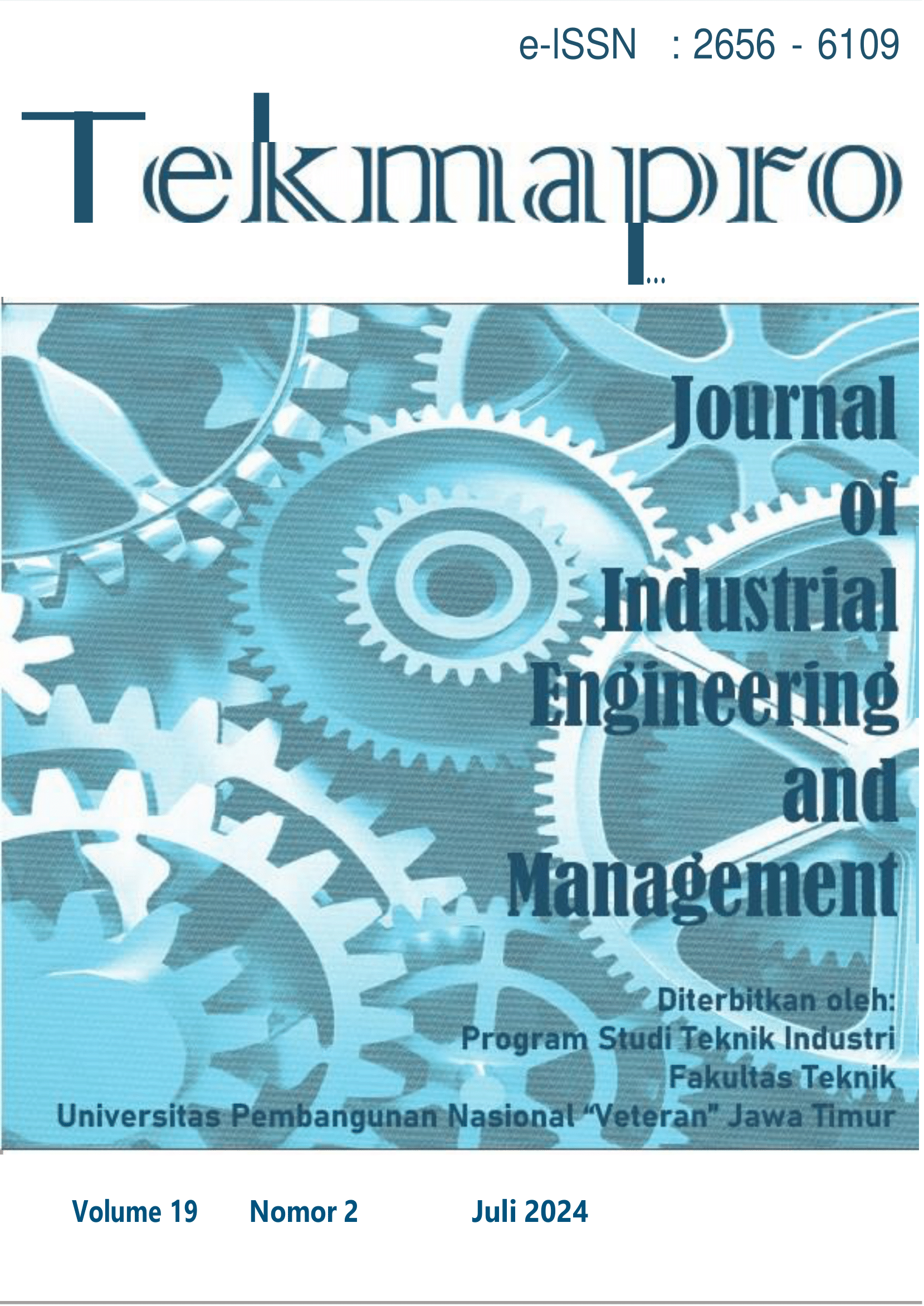A DUAL-CHANNEL SUPPLY CHAIN STRUCTURE ANALYSIS OF CONSUMER BEHAVIOR IN SHOPPING CHANNEL PREFERENCES
Keywords:
dual-channel supply chain, consumer behavior, switching intention, SEM PLSAbstract
Physical stores and online stores are one way that companies can continue to survive amidst competition by increasing profits from these two channels. Clothing is one of the textile commodities that is widely traded through physical stores and also online stores. This research identifies the factors that have the most significant influence on consumer preferences in choosing physical stores or online stores. Determining the factors involved adopts the results of previously conducted research. Based on existing research, there are several factors, namely Financial Risk (FR), Performance Risk (PerR), Psychological Risk (PsyR), Perceived Risk (PR), Environment Quality (EQ), Service Quality (SQ), Internet Experience (IE ), and Switching Intention (SI). From these variables, 8 hypotheses were formed. All hypotheses from the model were processed using Structural Equation Modeling with SmartPLS 3 software, it was found that H1, H2, H3, H4, H5, and H7 were accepted. H6 and H8 are rejected.
Downloads
References
D. Chaffey, Internet marketing : strategy, implementation and practice. Financial Times Prentice Hall, 2006.
E. Widodo, ‘PENETAPAN HARGA BERBASIS PENERIMAAN KONSUMEN DI DUAL-CHANNEL SUPPLY CHAIN’, Jurnal Teknik Industri, vol. 15, no. 1, pp. 1–8, 2014, [Online]. Available: www.apjii.or.id.
J. Zhang and M. Wang, ‘Pricing and warranty decisions in a dual-channel supply chain with warranty’s quality signal’, in Procedia Computer Science, Elsevier B.V., 2023, pp. 198–207. doi: 10.1016/j.procs.2023.10.004.
G. Li, L. Li, and J. Sun, ‘Pricing and service effort strategy in a dual-channel supply chain with showrooming effect’, Transp Res E Logist Transp Rev, vol. 126, pp. 32–48, Jun. 2019, doi: 10.1016/j.tre.2019.03.019.
C. Tian, T. Xiao, and J. Shang, ‘Channel differentiation strategy in a dual-channel supply chain considering free riding behavior’, Eur J Oper Res, vol. 301, no. 2, pp. 473–485, Sep. 2022, doi: 10.1016/j.ejor.2021.10.034.
M. Rahmah, J. Gunawan, and G. W. Bramanti, ‘Identifikasi Faktor - Faktor yang Mempengaruhi Switching Intention dalam Memprediksi Switching Behavior Nasabah Bank Konvensional Beralih ke Bank Syariah’, JURNAL SAINS DAN SENI ITS, vol. 9, no. 2, 2020, Accessed: May 12, 2024. [Online]. Available: https://www.google.co.id/url?sa=t&source=web&rct=j&opi=89978449&url=https://ejurnal.its.ac.id/index.php/sains_seni/article/download/55067/6543&ved=2ahUKEwimr7-TlIiGAxXca2wGHd-aCs0QFnoECBUQAQ&usg=AOvVaw2ad9FKXTEYrTxQyCwKAQ1Z
J. F. Hair, W. C. Black, B. J. Babin, and R. E. Anderson, Multivariate Data Analysis, 7th ed. Pearson Prentice Hall, 2010.
C. Song, B. Xu, and L. Xu, ‘Dual-Channel Supply Chain Pricing Decisions for Low-Carbon Consumers: A Review’, Journal of Intelligent Management Decision, vol. 2, no. 2, pp. 57–65, May 2023, doi: 10.56578/jimd020202.
D. Sinoimeri and J. Teta, ‘Systematic Literature Review of Supply Chain Management’, Proceedings of The International Conference on Business, Management and Economics, vol. 1, no. 1, pp. 16–21, May 2024, doi: 10.33422/icbmeconf.v1i1.195.
S. R. Sudarshan, A. Thomas, and M. Suresh, ‘Supply Chain Integration in Marketing: A Literature Review’.
H. Ye, X. Hu, and M.-E. Xie, ‘Research on Consumer Channel Choice Behavior in Dual-channel Green Supply Chain Based on Structural Equation Modeling’, in Proceedings of the 2022 5th International Conference on E-Business, Information Management and Computer Science, in EBIMCS ’22. New York, NY, USA: Association for Computing Machinery, 2023, pp. 219–225. doi: 10.1145/3584748.3584785.
M. Zhang, S. Ying, and X. Xu, ‘Dual-Channel Supply Chain Coordination with Loss-Averse Consumers’, Discrete Dyn Nat Soc, vol. 2023, 2023, doi: 10.1155/2023/3172590.
J. Xu, Q. Meng, Y. Chen, and J. Zhao, ‘Dual-Channel Pricing Decisions for Product Recycling in Green Supply Chain Operations: Considering the Impact of Consumer Loss Aversion’, Int J Environ Res Public Health, vol. 20, no. 3, Feb. 2023, doi: 10.3390/ijerph20031792.
E. Widodo, O. Novawanda, B. Syairudin, and A. B. R. Indah, ‘A model of technological enhancement of consumer behavior analysis using the push pull mooring approach in dual-channel apparel retailer’, in IOP Conference Series: Earth and Environmental Science, IOP Publishing Ltd, Oct. 2020. doi: 10.1088/1755-1315/575/1/012068.
J. K. Hsieh, Y. C. Hsieh, H. C. Chiu, and Y. C. Feng, ‘Post-adoption switching behavior for online service substitutes: A perspective of the push-pull-mooring framework’, Comput Human Behav, vol. 28, no. 5, pp. 1912–1920, 2012, doi: 10.1016/j.chb.2012.05.010.
A. Nugroho and W. T. Wang, ‘Consumer switching behavior to an augmented reality (AR) beauty product application: Push-pull mooring theory framework’, Comput Human Behav, vol. 142, May 2023, doi: 10.1016/j.chb.2022.107646.
Sugiyono, Metode Penelitian Pendidikan Pendekatan Kuantitatif, Kualitatif, dan R&D. Bandung: CV. ALFABETA, 2016.
J. F. Hair, C. M. Ringle, and M. Sarstedt, ‘Partial Least Squares Structural Equation Modeling: Rigorous Applications, Better Results and Higher Acceptance’, Long Range Planning, vol. 46, no.1–2. Elsevier Ltd, pp. 1–12, 2013. doi: 10.1016/j.lrp.2013.01.001.
S. Park and D. Lee, ‘An empirical study on consumer online shopping channel choice behavior in omni-channel environment’, Telematics and Informatics, vol. 34, no. 8, pp. 1398–1407, Dec. 2017, doi: 10.1016/j.tele.2017.06.003.
W. W. Chin, ‘The partial least squares approach for structural equation modeling.’, in Modern methods for business research., in Methodology for business and management. , Mahwah, NJ, US: Lawrence Erlbaum Associates Publishers, 1998, pp. 295–336.
J. F. Hair, G. T. M. Hult, C. M. Ringle, and Marko. Sarstedt, A primer on partial least squares structural equation modeling (PLS-SEM).
Jacob Cohen, Statical Power Analysis for the Behavioral Sciences, 2nd ed. New York: Lawrence Erlbaum Associates Publishers, 1988.
Paulus Insap Santosa, Metode Penelitian Kuantitatif Pengembangan Hipotesis dan Pengujiannya Menggunakan SmartPLS, 1st ed. Yogyakarta: Penerbit ANDI, 2018.










